More juice: squeezing the best from Souza, Hamer and Archer
Riley Roberts applies tactical solutions to the problem of underperforming summer signings.
One thing that is irking me about the Blades is how poor we’ve been at utilising the players at our disposal. We’ve failed to squeeze enough juice from all three of our marquee summer signings — did it have to be this way?
It is said in football, that the job of a certain tactical set-up or system is to mask your players’ weaknesses and get the most out of their strengths. The relevance of this for teams like Sheffield United in the Premier League — who do not possess the elite players capable of transcending tactical structures — is enhanced tenfold.
Right now, we’re masking little and strengthening less. Players are playing out of position, they are too often tasked with jobs outside their comfort zone, and we’re seemingly unable to maximise the potential of a talented trio: Vinicius Souza, Gustavo Hamer, and Cameron Archer. It’s a waste. But we can change it.
Vinicius Souza
I’ve been critical of Vinicius Souza, and I still believe that we could have signed a better player for the same money. However, I’ve come to realise that some of my frustrations are being aimed in the wrong place: it’s not simply his failings.
Souza’s skillset has its limitations, even his biggest fan would tell you that, but we’re failing to maximise his strengths, and we do not do anywhere near a good enough job at accounting for his weaknesses. The end result? He ends up looking like a far worse player than he probably is.
What is good about Souza?
Good tackler 1v1
Can shuttle to protect the back 4 and cut passing lanes
Large frame makes him hard to out-strength in duels
Aerial ability
Long passing range
What is not good about Souza?
Loose in possession and tends to under-hit passes
Struggles to turn after receiving with his back to goal
Lacks creative passing ability
Doesn’t carry the ball well
At the minute, we’re not doing a good job of masking his weaknesses at all. In our current set-up, as the deepest midfielder, he’s the one being tasked with the role of our main ball progressor in the middle of the pitch; a job he is ill-suited to do.
The issue is quite simple. Souza often receives the ball from the CBs with his back to goal, and opposition teams are very happy to let us build up in this way as they know it’s a weakness for Souza and therefore a good trigger to put him under pressure, forcing either a turnover or backwards pass.
As the below table shows, Souza miscontrols the ball once in every 35 touches or so, which is just over once per game on average. For comparison’s sake, Hamer who is significantly riskier in his play and receives passes in much more dangerous areas, miscontrols every 44 touches. And Norwood, who receives passes in a similar area to Souza miscontrols every 135 touches. This shows just how badly suited Souza is at receiving these kinds of passes.
To my eyes, our set-up right now is essentially a self-inflicted death sentence. It almost guarantees that we struggle to get control over the middle of the pitch, struggle to create any spells of sustained possession and struggle to progress the ball into more dangerous areas to create chances.
The data matches up with the eye test. We create the least Expected Threat per game in the league (0.98). We have the lowest “build-up” pass completion (69.5%), meaning our system is ineffective from a progression standpoint. And opposition teams also complete more defensive actions higher up the pitch against us than against another team in the league (48.6m from their own goal). In short, our current set-up is a problem.
How can we resolve this?
We’ve already established that Souza receiving with his back to goal is something that is provably hindering our play. So, my suggestion is for Souza to drop into the “first line” or back 4 when we have deep possession. This solution would allow Souza to receive the ball with the game ahead of him. The results of this could bring clear benefits:
Souza wouldn’t be required to turn on the ball;
Thus, he would be less likely to give the ball away in dangerous areas;
And, there’s a greater likelihood that he could deploy his passing range to play long passes, something we haven’t enough.
The benefits it brings do not just stop at Souza either, this shape can increase the effectiveness of numerous other players too, for example:
It helps create a 4v4 against the opposition backline — thus, a better chance of isolating Bogle and Diaz 1v1 and increased effectiveness of outballs and long balls over the top, instead of the predictability of hitting McBurnie at every opportunity.
It forms diamonds and triangles all over the pitch, meaning much better passing options and angles.
It means Anel can play higher and wider, something closer to replicating his role from last season.
It doesn’t have to stick in the 4-4-2/4-2-4 shape either and I’m not saying Souza should be a CB, just that he should drop into the backline for build-up purposes. As the ball moves up the pitch, Souza can too. For example, when we have the ball high up the pitch, he can assume a position just ahead of the backline while always staying behind the ball, recycling possession when it comes back to him and acting as a shield for the defence on counters when we lose it.
Put simply, we would get more out of Souza if we can get him behind the ball and facing forwards. Doing so will unlock his passing range and put him in less risky situations where he tends to turnover possession while also allowing him to sit in front of the defence when we have possession high up the pitch, letting him break up counterattacks.
Gustavo Hamer
Leading on nicely to another one of our summer additions in midfield. And another, in my opinion, who has poorly utilised. The quality Hamer possesses is undeniable and we’ve definitely seen flashes of what he can do, but I still think there’s more to come from him.
What is good about Hamer?
Good passing range
Excellent Vision
Line-breaking passing ability
Reliable progressor from deep via both passing and carrying
Late arrivals into the box = goals
Close control in tight spaces
What is not good about Hamer?
Rash and sometimes over-aggressive in the tackle.
Struggles aerially
Poor ball retention (mainly due to trying lots of risky passes)
What is the problem?
…We don’t get Hamer on the ball enough.
Why?
…His positioning in possession is usually too high up the pitch.
This example from the loss against Luton on Boxing Day perfectly highlights my point. Hamer is good in the final third, we all know that. But should he be almost in line with the strikers? Obviously not.
Hamer’s (far too) advanced position underutilises his passing range because, high up the pitch, he ends up playing backward passes most of the time. In this set-up, we’re not making use of his ability to control games and progress the ball from deep, because it limits his opportunities to receive the ball in build-up.
How can we resolve this?
#1 In Possession
Well, luckily, I believe my solution for bringing more effectiveness out of Souza also aids the use of Hamer too.
In build-up, Hamer would be part of a double pivot where we can make use of his close control and quick thinking to help play out under pressure. We could make use of third-man combinations to play with a much-increased tempo and intensity than we do now, freeing Hamer in the middle of the park where he could:
Look to play a through ball in behind;
Play into McAtee to receive in between the lines;
Or carry the ball forwards himself.
#2 Out of possession
Beyond build-up, we’re not getting the best from Hamer when we’re out of possession. If you go and watch his highlights for Coventry, you will quickly realise that almost all of his significant contributions came in transition — the moment when one team loses the ball and the other gains possession.
Last season, Coventry created more chances on the counter and more chances following high-pressing regains than any other team in the Championship and Hamer played a significant part in that. Here’s his defensive data from last season with Coventry (who averaged around 47% possession per game) vs this season with us (36%).
As a general rule, when a midfielder, or any player for that matter, plays for a team who have less possession you should expect that they would make more tackles, more interceptions, more blocks. It makes sense because their team is having to try to win the ball back more often.
With Hamer, this isn’t the case at all. And the biggest reason is that he is playing in a team who are too happy to concede possession and that don’t enable him to channel his aggression positively, hunting balls down in the final third and creating chances off the back of that. A key indicator of that in the stats is that the only metric which he has gone up in, is the number of clearances, suggesting that he is operating, at least defensively from a much deeper position than he was for before.
On average, no team in the league lets opponents gain more ground in sequences starting from a goal kick than us (48.52m). This shows how poor of a job we do at disrupting opposition build-up. Now, I’d forgive you if your initial reaction to this was to be like:
“Well, we’re one of the worst teams in the league, on one of the lowest budgets so it’s expected that we sit back a bit more.”
And while I’d agree with the sentiment behind that, it’s worth noting that by this metric the other two teams in the league on a similar budget to us in Luton and Brentford rank 5th (33.48m) and 1st (23.18m) respectively. This shows that this loser attitude of giving teams too much respect MUST go.
To be fair to us, our actual defensive shapes have not been bad at all I don’t think, especially since Wilder came in. A 4-1-4-1 is a great base formation out of possession due to its flexibility: it is never more than a few movements away from becoming several different shapes such as a 4-4-2 or 4-3-3. When utilised correctly, it also does good work in denying the opposition central access.
However, I have a problem. We are too willing to allow opponents possession and fail to engage high up the pitch, and that feels like a big waste of our energetic and aggressive players such as Hamer, BBD, Brooks and McBurnie. They all have the mental and physical attributes suited to a high press.
The above set-up is just one example of how we can be more proactive without the ball, getting the most out of these players. In this structure, the CF is tasked with screening passes into the #6 while the 3 in midfield outnumber the opposition’s 2. This leaves the team in possession with no central passing options. The idea would be that we use a pass from one CB to the other as a trigger for a CM to jump up and put pressure on the receiving CB.
This pressing structure would usher the opposition’s build-up play wide where we can then force the ball out of play or turn the ball over in the opposition half and allows us to get Hamer into dangerous positions in transition if we were to win the ball back.
Cameron Archer
Archer is by far the hardest player to accommodate. He’s a player who thrives off of working alongside a partner upfront, and until the 3-1 win at Luton, Wilder hasn’t trusted him to be the lone man. For the most part, he’s been playing on the wing and although it’s a position he played when he was breaking through in Villa’s youth ranks, we’re clearly not getting the best out of him either.
What is good about Archer?
Top ball-striking ability and finisher
Good movement off the ball
High football IQ, always scanning prior to receiving the ball
Good burst of pace
Impressive vision and passing ability for a CF
What is not good about Archer?
Struggles with holding the ball up
Aerially ineffective
Not particularly involved in build-up
The problem with the way Archer is being used is obvious. He is not a winger, simple as. He’s not suited to being a lone striker either though, which makes him very hard to fit into a one-up-top formation.
How can we resolve this?
Well in Archer’s case, as he is a player who is leaving the club at the end of the season anyway, I propose two solutions:
Don’t adjust the team to his needs and just use him as an impact sub for when we need a goal.
Switch to a 2-striker formation to allow Archer to flourish.
Wilder deployed a three-at-the-back formation against Villa, and it seems likely that it will continue, at least some of the time. So how would I go about fitting Archer into this, while still keeping the ideas to get the best out of Hamer and Souza in place?
Interestingly, the 4-2-4 build-up shape I presented earlier was something that Hecky flirted with in pre-season, which itself came from base formation of 3-5-2 with a midfielder dropping into the backline and the WBs pushing high up the pitch stretching the opposition backline.
In the game against Stuttgart when we played this way, it proved to be catastrophic, particularly in transition. However, when you look at the individuals on the pitch that day (Osborn-Slimane pivot, Osula-Traore front two), I’d say that was a bigger factor in our poor performance than the shape we took up in build-up.
This does have a few issues, mainly with the wingback being the main width providers in attack, meaning they have to cover an extreme amount of ground due to the constant moving from attack to defence and vice-versa.
Out of possession, the 5-3-2 allows us to revert to doing what we did best the last time we were in the Premier League, frustrate teams.
With the 5-3-2 vs a midfield box, we can gain a 5v4 in the centre of the pitch, forcing teams to play wide and to play long, something we did to great effect in 19/20.
That season, no metrics painted us as a team who were great in the press, but we proved you don’t need to be a gung-ho “gegenpressing” team that commits everyone forward and plays a super high line to cause disruption to the opposition. And with Davies, Souza and Hamer we’d be able to replicate the midfield work-rate we had back in the “good old days.”
Conclusion
Ultimately, these are ideas. Tactics are always theoretical, but I think it’s clear enough to any fan that we’re not getting the best out of our key players. Let’s not forget that the players discussed are our marquee summer signings, all of whom have significantly underperformed their full potential so far in the red and white. In theory, we can get more out of them. By amplifying their strengths and masking their weaknesses, who knows, we might just reach 15 points.


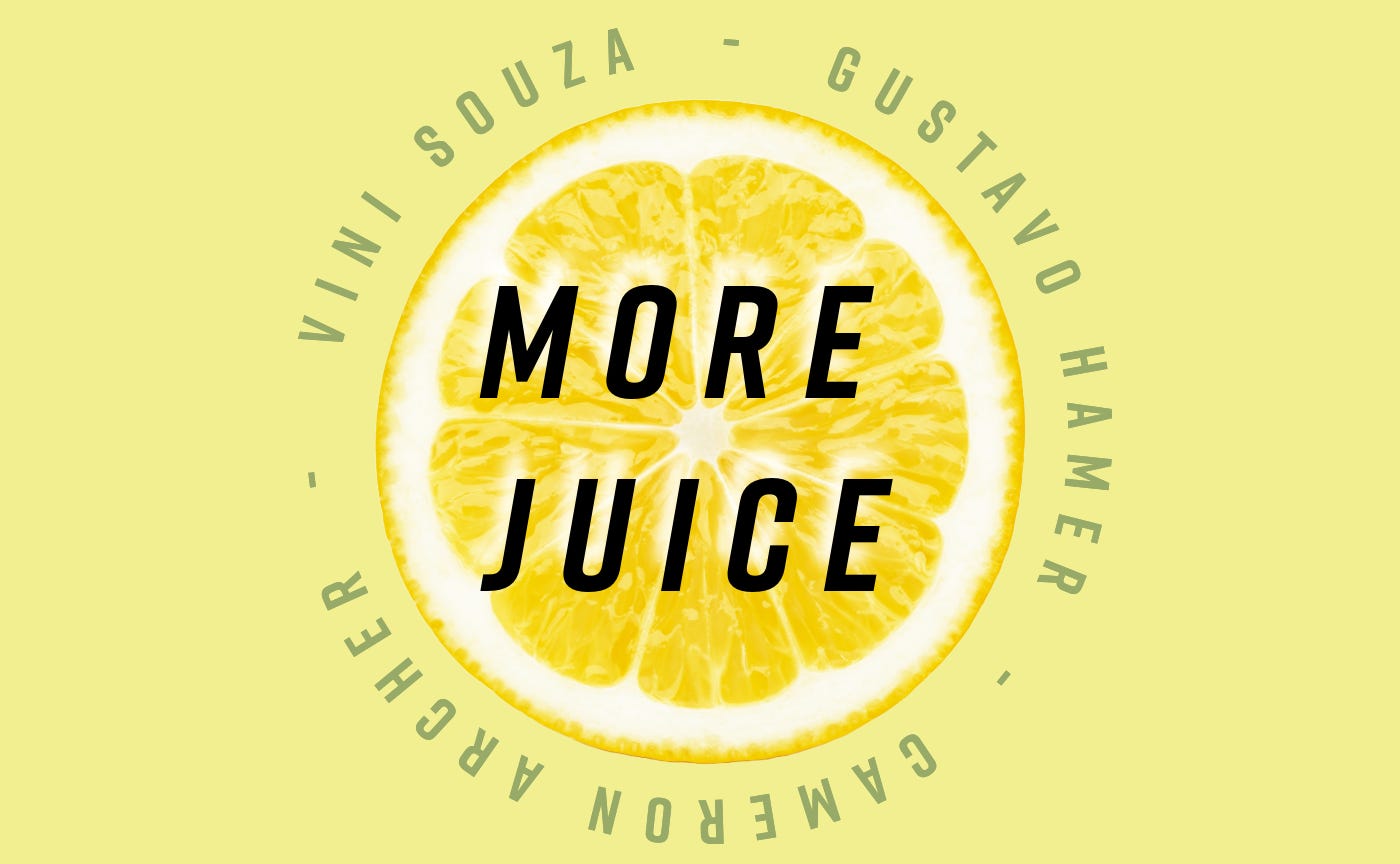
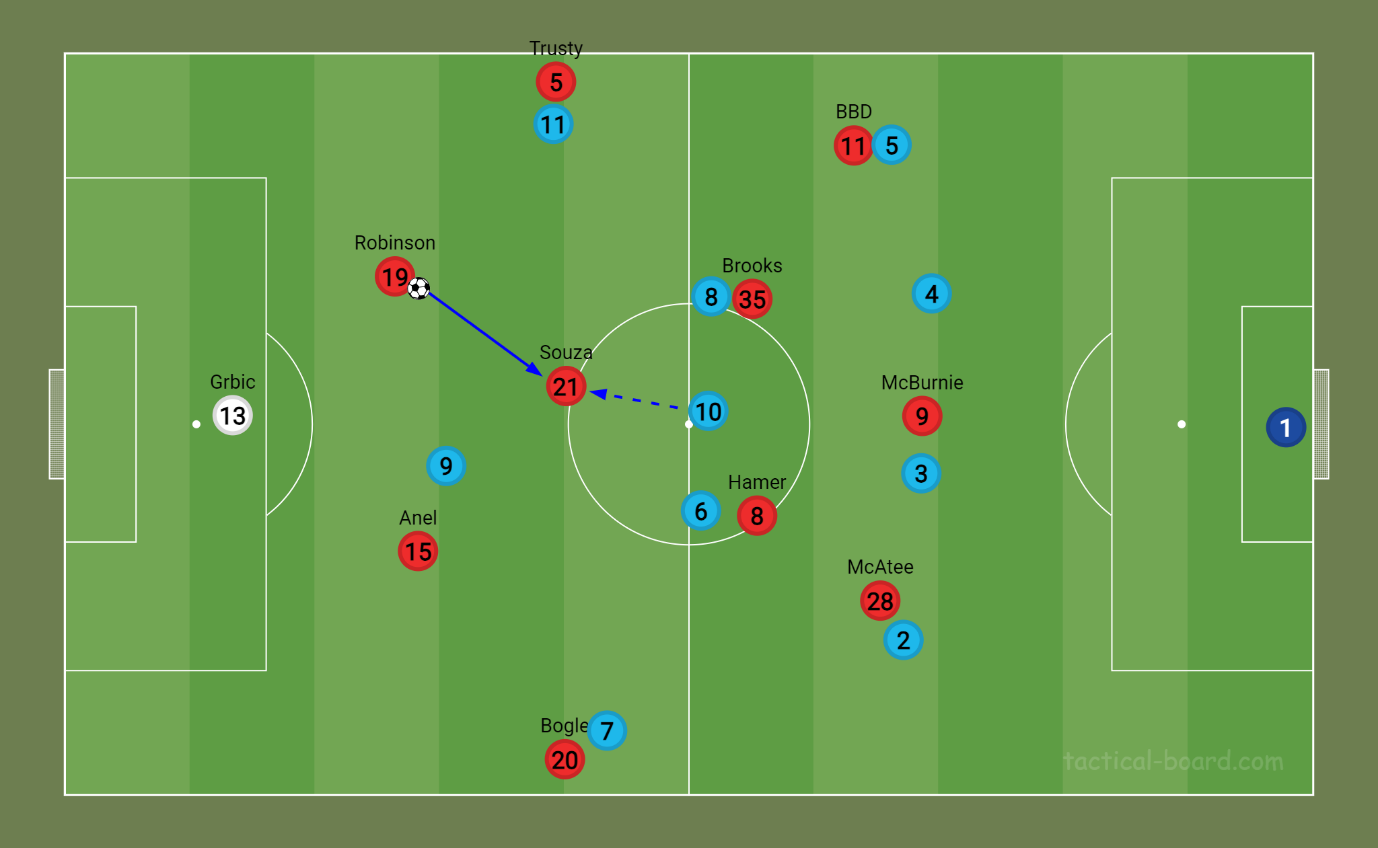
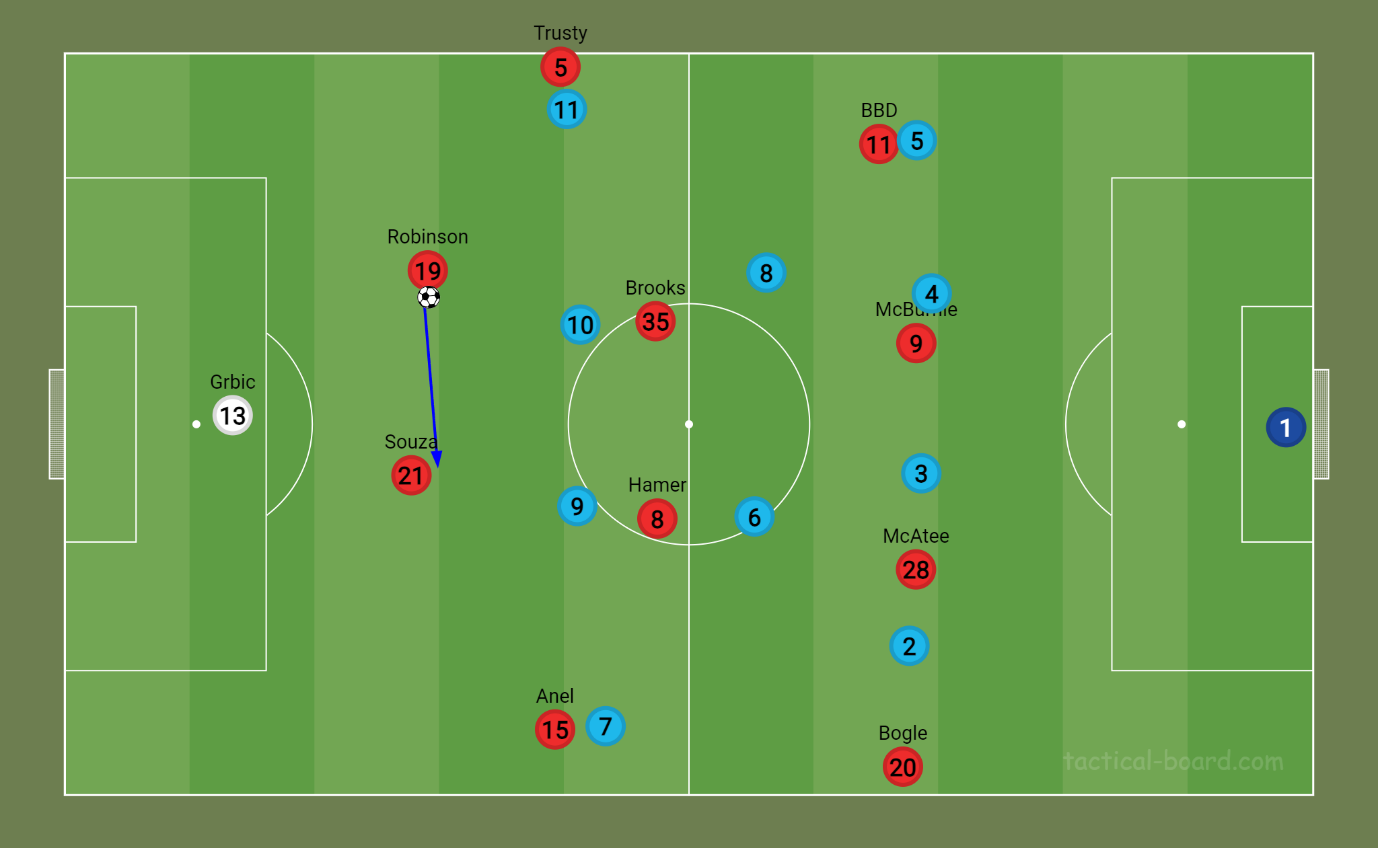
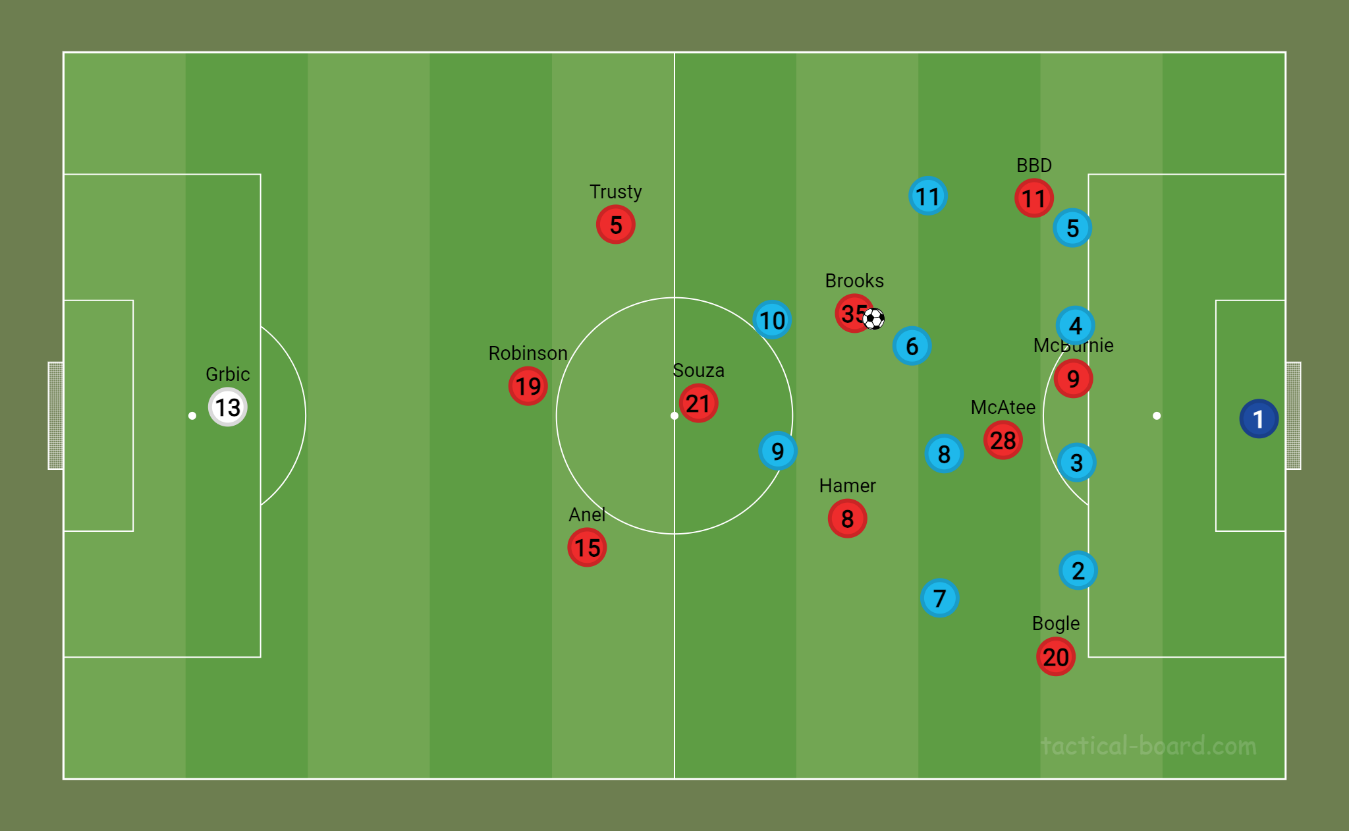
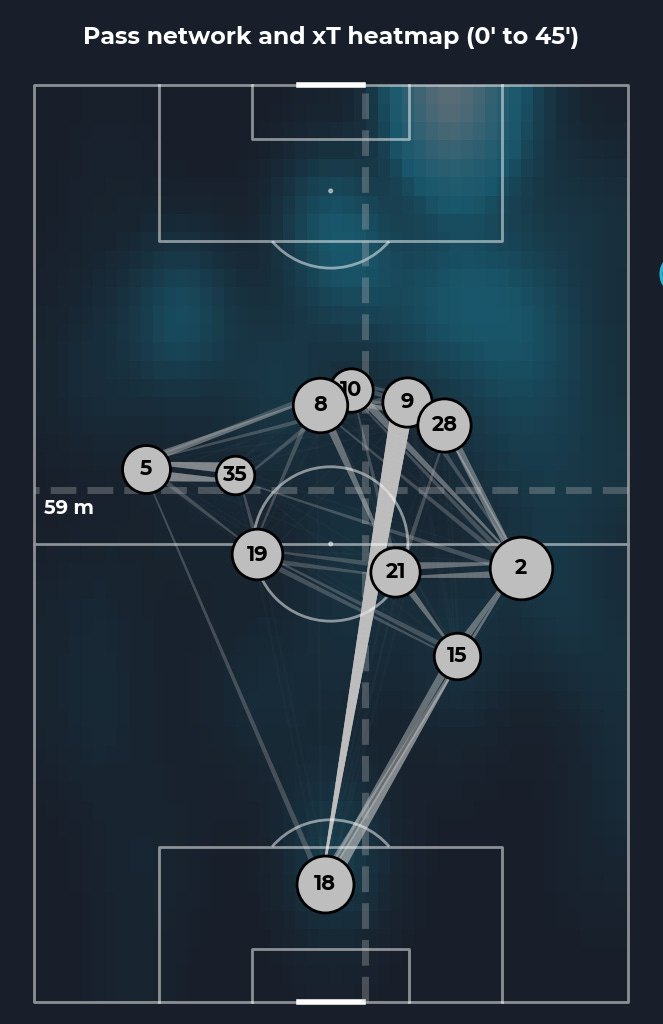
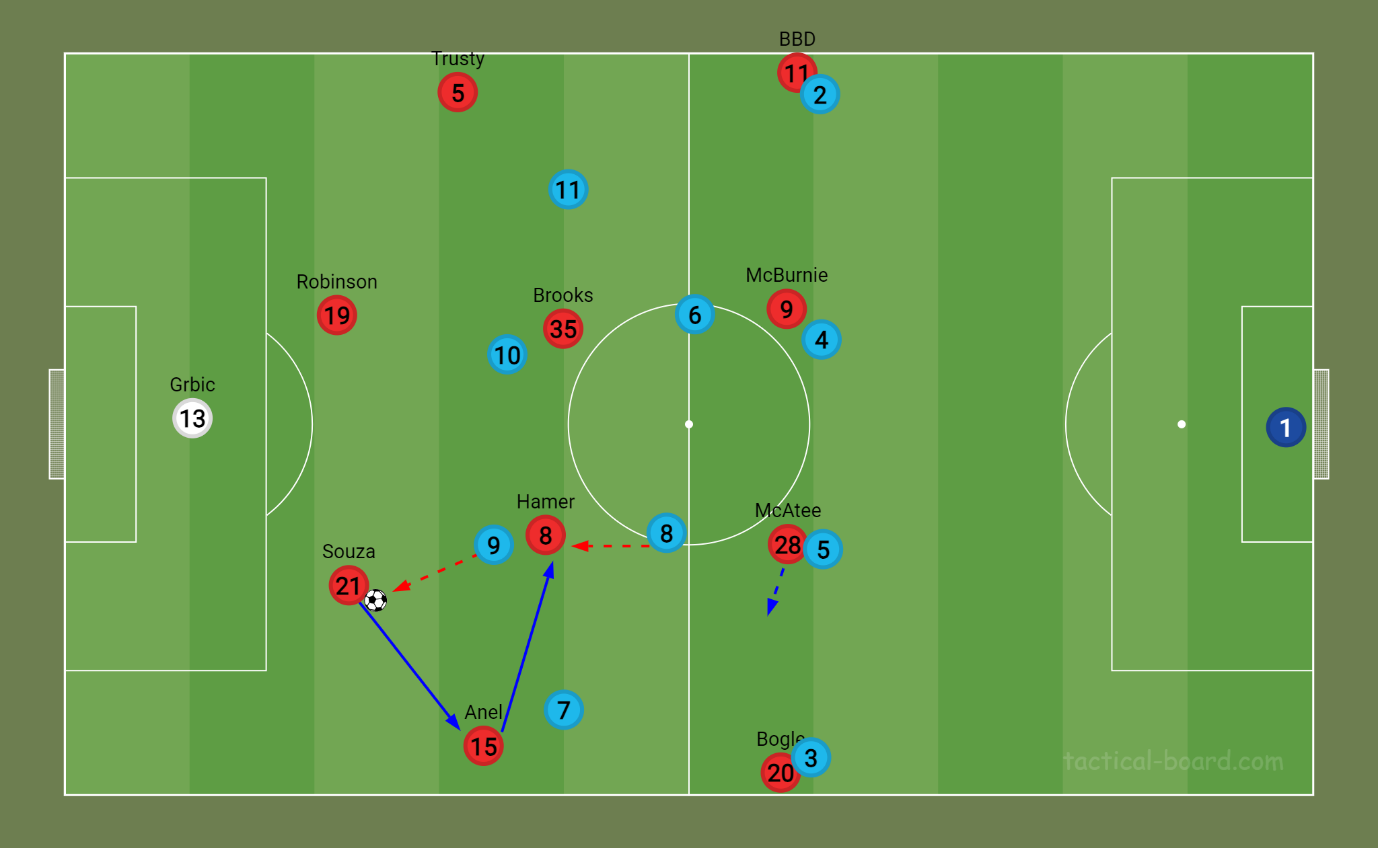
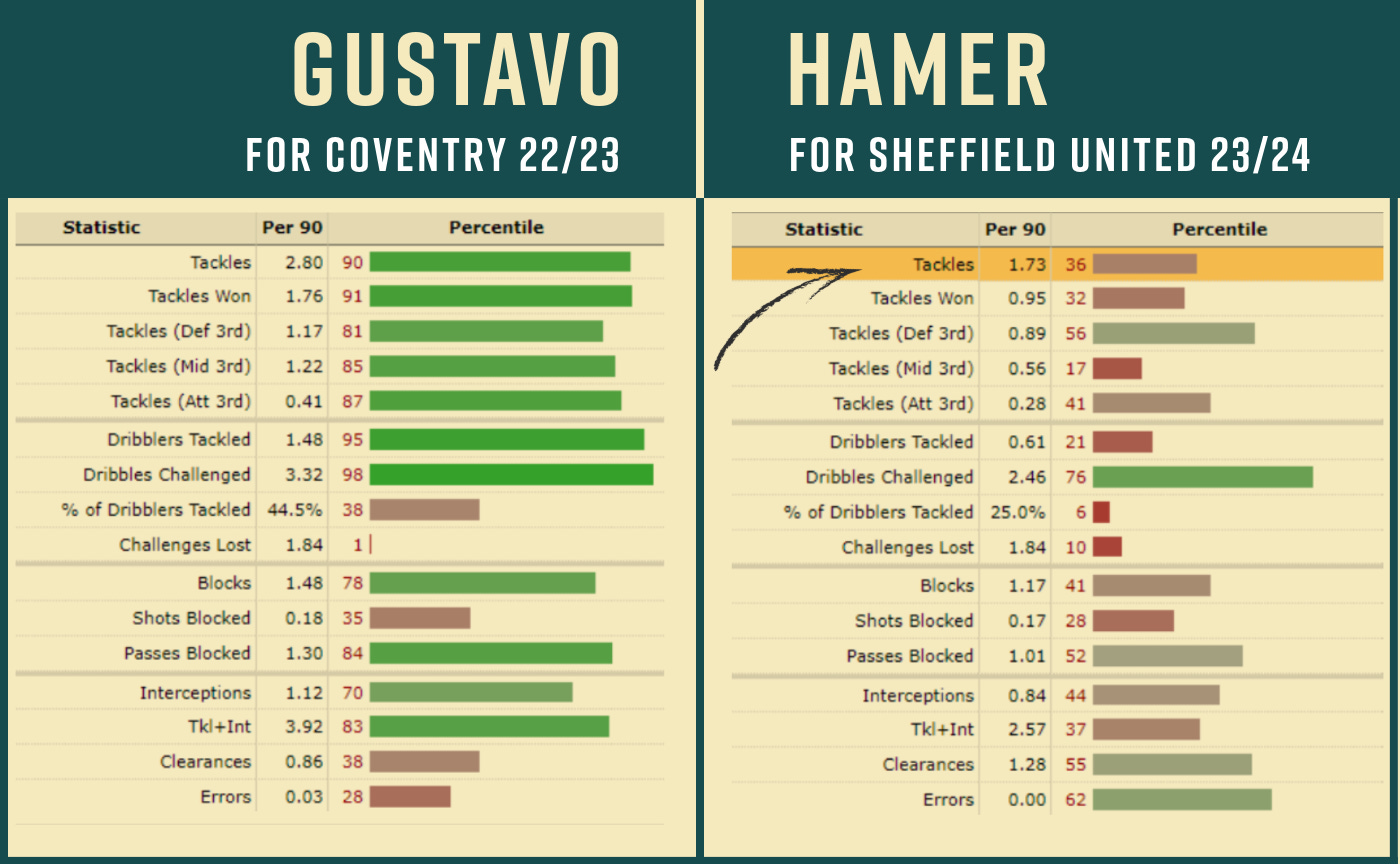

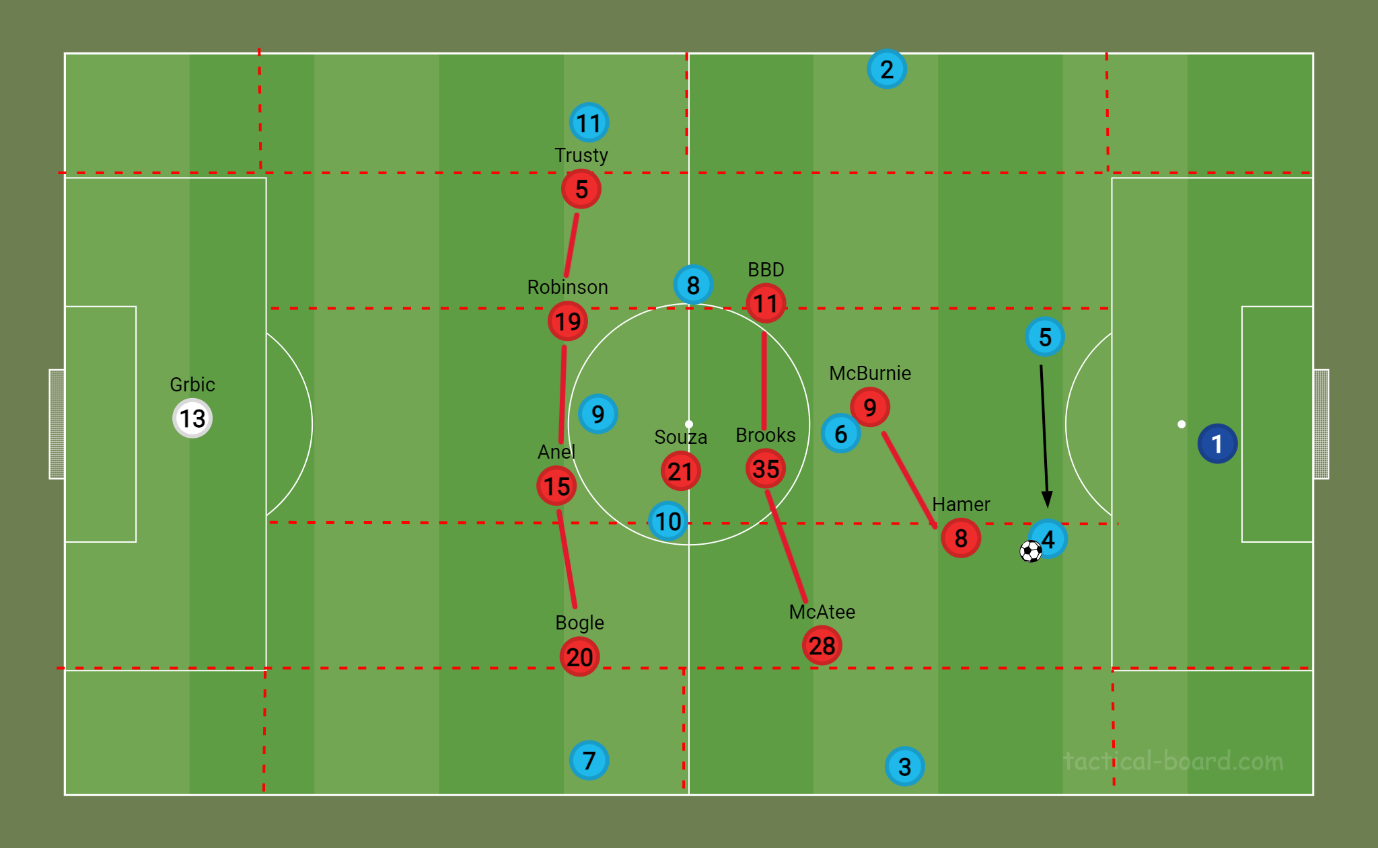
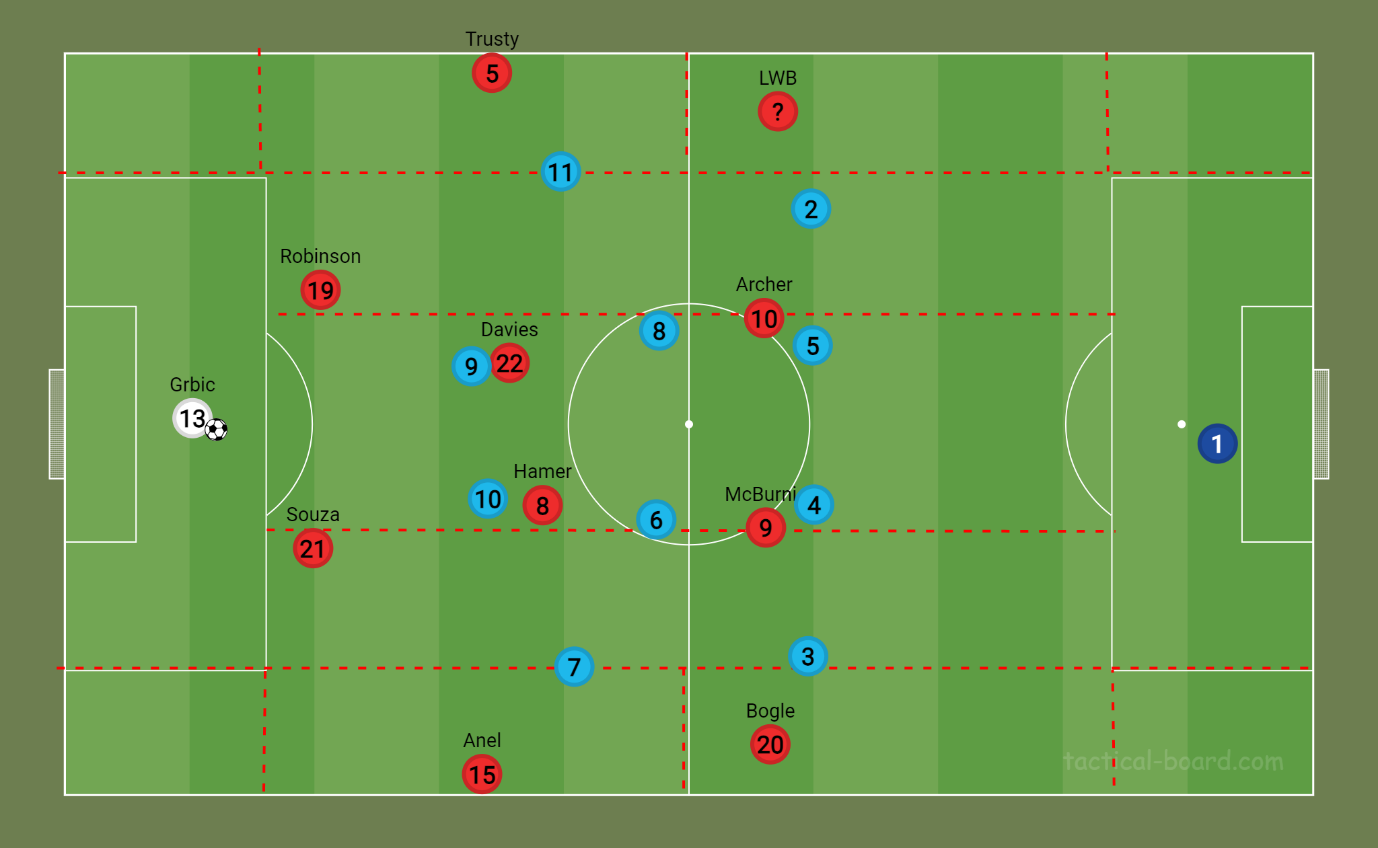

Thanks, Riley
“Players are playing out of position, they are too often tasked with jobs outside their comfort zone…” Got it in one!
Souza can’t turn on a sixpence like Ndiaye could – so yes, we need to get him (and his feet) into the right position to work to his other strengths.
“…don’t enable him to channel his aggression positively, hunting balls down in the final third and creating chances off the back of that.” Exactly so – Hamer always seems to be “stuck” surrounded by opposition players and can’t often showcase what he (with his speed and good vision) can do.
“Tactics are always theoretical…” but – from your words to Wilder’s ear!!
Sue.